Research Article - (2024) Volume 21, Issue 4
The Need to Implement Noise Reduction Measurements in a Neonatal Intensive Care Unit in Hospitals in Low and Middle Income Countries-a Case Study
David Emmanuel Del Pozo1,
Natalia Carolina Donoso1*,
Galo Antonio Ojeda1,
Bryan Gabriel Valle1 and
Manuel Jesús Gázquez2
1Departamento de Química, Universidad Técnica Particular de Loja, San Cayetano Alto s/n, 110107, Loja, Ecuador
2Departamento de Física Aplicada, Universidad de Cádiz, República Saharahui s/n, 11510 Puerto Real, Spain
*Correspondence:
Natalia Carolina Donoso,
Departamento de Química, Universidad Técnica Particular de Loja, San Cayetano Alto s/n, 110107, Loja,
Ecuador,
Email:
Received: 29-Mar-2023, Manuscript No. ipdehc-23-16507;
Editor assigned: 31-Mar-2023, Pre QC No. ipdehc-23-16507 (PQ);
Reviewed: 14-Apr-2023, QC No. ipdehc-23-16507;
Revised: 19-Apr-2023, Manuscript No. ipdehc-23-16507 (R);
Published:
26-Apr-2023, DOI: 10.21767/2049-5471.21.04.37
Abstract
Purpose: Improving the Neonatal Intensive Care Unit (NICU) noise conditions in public hospitals is challenging, especially in low and middle-income countries. The Isidro Ayora General Hospital in Loja-Ecuador does not fall out of this reality. Therefore, this case study evaluates the noise levels in a NICU of a public hospital and proposes a noise mitigation program based on the obtained results.
Methods: A descriptive, observational, and quantitative study was carried out to determine the A decibels to which newborns at two NICUs are exposed. An HD2010UC/A Class 1 integrating portable sound level meter was used to detect noise pollution. Data were recorded in 60 seconds intervals during 24 continuous hours for 7 days. The device was placed at the basic (NICU-B) and intensive-intermediate (NICU-IEI) units, considering height and wall proximity.
Results: In the NICU-B maximum and minimum values were 74.1 and 49.7 dBA; an equivalent daily noise level of 49.3 dBA was recorded. In the NICU-IEI, values were between 71.4 dBA and 47.9 dBA, and the equivalent daily noise level was 53.1 dBA. These results exceed the recommended levels by the World Health Organization (WHO) and the Ecuadorian Ministerial Agreement 097-A, Regulatory Annex 5.
Conclusions: Other studies evaluating noise levels in other public hospitals in Ecuador or low and middle-income countries are necessary to support these findings. Noise levels in neonatal rooms should be known to implement noise reduction measurements such as incubators with effective acoustic attenuation characteristics, earmuffs to be used on neonates, periodical strict noise controls, etc.
Keywords
Neonates; NICU; Low and middle income countries; Public hospitals; Noise management
Introduction
According to the Development Bank of Latin America CAF, the minimal productivity in Ecuador and other Latin American countries is represented by low or null innovation, inefficient employment, and uneven capital distribution [1,2]. This is reflected in the decrease of 80% of the investments in health and education, while, investments in transport infrastructure are
the highest and remain invariable comparing the years 2021 versus 2022 [3]. Moreover, in Ecuador, several environmental challenges are experienced and expected to worsen in the coming years. Considering its size, Ecuador has the highest annual deforestation rate of any country in the Western Hemisphere and there is a significant loss of forest biomass. The country’s fossil fuel dependence, plus large-scale agricultural projects resulted in a significant depletion of natural resources, biodiversity, and important contributions to environmental pollution [4]. Furthermore, the majority of anthropogenic projects did not receive an efficient environmental assessment since the political and economic power is not focused on the well-being of the society. The reduced numbers of reported environmental studies evaluate the impacts of water or air pollution on Ecuadorians, mainly living in the capital, but little to no attention has been given to the effects of environmental pollution on citizens from small cities [5-9]. Noise pollution is a globally growing problem that is rapidly increasing and affecting the population at all stages of life. Moreover, a large part of the population does not realize how it affects their health. In Ecuador, only a few reported scientific studies evaluate the effect of noise pollution on the population [5,6,10]. Accordingly, the most vulnerable to noise health threats are pregnant women, fetuses, newborns, infants, and children commonly gathering at workplaces, commercial and industrial areas, hospitals, and educational institutions [11]. Pregnant women and children exposed to loud sounds for a prolonged time have a higher risk of having temporary or permanent hearing loss depending on the loudness and duration of exposure [11]. Thus, there is a need for frequent and strict controls of noise levels, the implementation of protective measures, and public education regarding the health hazards of noise.
Focusing on noise levels at hospitals and mainly at NICUs, special attention is needed. These areas are designed to support the recovery and evolution of premature newborns or those with harsh diseases that require special care [12-14]. These are usually classified into basic, intermediate, and intensive care units, according to the treatments and care that newborns need for their recovery and growth [15]. NICUs must meet some minimum environmental quality criteria, so that newborns have adequate conditions for their growth, during the first months of life [16]. An appropriate level of light, temperature, humidity, oxygen, and absence of noise are important factors that require permanent control.
Several studies have shown that noise in NICUs has a clear relationship with the newborn’s physiological, neurological, and motor development. Excessive noise generates adverse effects such as sleep disorders, poor development of responses to stimuli, affectation of the nervous system, growth delays, and even decreased hearing capacity [17-19]. Newborns in NICUs are exposed to an overload of sound stimuli from different sources such as the ones generated by the alarms of the medical equipment, telephones, conversations of the medical personnel, the closing, and opening of doors, monitors, incubators, ventilatory circuits, visitors and, cleaning staff shifts, among others [12,13,16-20]. The majority of reported cases concluded that recorded noise levels exceed the suggested limits by the WHO, the United States Environmental Protection Agency (EPA), and American Academy of Pediatrics (AAP), and/ or Ecuadorian environmental regulations such as the Unified Text of Secondary Environmental Legislation (TULSMA) [12,21]. On average, the noise levels in these units can range from 50 dBA to 75 dBA, sometimes they present peaks that exceed 100 dBA and some prolonged sounds remain in ranges of 70 dBA to 80 dBA [13,22-24]. Until 2018, the WHO reported that 15 million babies are born preterm each year and that the tendency keeps increasing [25]. In 2019, the National Institute of Statistics and Censuses of Ecuador (INEC) informed that 18.8% of all fetal deaths correspond to preterm babies born between weeks 36 and 38 of gestation [26]. The same year, from a total of 285,827 newborns, 5.1% were premature, thus, received specialized care at NICUs. Certainly, NICUs have ensured the well-being and survival of babies; however, neonatal hospitalized in these areas are exposed to constant noise associated with the monitoring and follow-up of their vital signs [27] and to environmental factors that could harm their physical conditions [20]. Newborns tend to show signs of stress or forms of self-regulation as a defense mechanism against possible disturbances, these are intended to control them; however, the energy they need is mainly for their recovery processes [28]. The physiological effects that are manifested in newborns due to noisy stimuli are hypoxemia, bradycardia, increased intracranial pressure, arterial hypertension, apnea, stress, disorganized behaviors, and metabolic instability since their caloric requirements increase from glucose; in addition, sleep disturbances, irritability, tiredness, nausea, and loss of appetite occur [29].
The AAP establishes a series of recommendations to minimize noise levels in NICUs by improving their management and promoting research to determine the effects of noise on pregnant women, their fetuses, and newborns. EPA establishes not to exceed 45 dBA for the daytime period and 35 dBA for the nighttime period inside hospitals, in addition, the AAP ratifies the importance of monitoring noise levels inside NICUs, showing a maximum noise level of 45 dBA [30]. Table 1 shows a compilation of maximum acceptable noise levels established in the TULSMA [21].
| Agencies, Organizations, and Regulations |
Equivalent Continuous Sound Pressure Level, or Leq/LAeq (dB) |
| Day |
Night |
| 7h01-21h00 |
21h01-7h00 |
| Environmental Protection Agency (EPA) |
45 |
35 |
| American Academy of Pediatrics (AAP) |
45 |
45 |
| Clinical Practice Guideline (CPG) |
40 |
40 |
| Spanish Association of Pediatrics (AEP) |
45 |
45 |
| World Health Organization (WHO) |
30 |
40 |
| Ministerial Agreement 097 Annex 5. Maximum noise emission levels and measurement methodology for fixed and mobile sources (TULSMA) |
55 |
45 |
Table 1: Compilation of maximum noise levels
In this sense, the objectives of this study are to identify, characterize, and assess the noise levels in the NICU of a typical medi-
um-sized hospital in the region of Loja, Ecuador. Subsequently, an evaluation of the main correlations of the noise sources is carried out, so that the right protection measures for noise reduction and elimination can be proposed.
Methods
The study was conducted in the NICU of the Isidro Ayora Regional Hospital. In 2020, the hospital registered a total of 2078 births between natural deliveries and cesarean sections. Currently, the NICU has a total of 30 beds provided for the care of newborns. These are distributed in 4 levels which consider the severity of illness and are presented as follows: 8 beds for isolated intensive care, 4 beds for intensive care, 8 beds for intermediate care, and 10 beds for basic care.
First, the different elements that compose the NICU-B and NICU-IEI were listed to recognize the dynamics of the medical staff and to identify the noise sources, the feeding schedules, and the personnel shifts that influenced this study. There was a variety of medical equipment within the different rooms of the NICU, such as DRÄGER open incubators, MINDRAY vital signs monitors, ventilators, drug administration pumps, oxygen pumps, BISTOS phototherapy lamps, and MEDIX radiant heat cribs.
Additionally, the dimensions of the studied NICUs were registered. The area of the NICU-B was 45.16 m2 and 2.40 m high. The area of the NICU-IEI was 168.17 m2 and 2.40 m high.
The sampling specifications established in the UNE-EN ISO 1996-1:2009 standard and Annex 5 of the TULSMA were considered to record noise measurements. A Delta OHM model HD2010UC/A type 1 integrating sound level meter was used, which was calibrated before and after the sampling period. The sound level meter was programmed to collect data using the A-weighting filter in fast mode. The noise measurements were taken at the NICU-IEI and NICU-B in 60 second intervals for 24 continuous hours for 7 days in each room.
The sound level meter was placed in strategic points where it did not obstruct the work dynamics of the medical staff. In the NICU-B the sonometer was placed on a tripod 1.50 m high from the floor and 1 m apart from the wall. The NICU-IEI was larger since it included two levels of care (intermediate and intensive) hence the equipment was placed 1.65 m high from the floor and 1.20 m apart from the wall to minimize rebound effects. The acoustic parameters recorded were: The average equivalent level of the A-weighted sound (LAeq), maximum noise level (LAFmax), minimum noise level (LAFmin), percentile-derived measurements; the 10th percentile (L10), and 90th percentile (L90) corresponded to the peak and background noise respectively.
Results
A total amount of 10080 noise data were recorded. These measurements correspond to 7 days of sampling for each room studied (NICU-B and NICU-IEI). These values were integrated in one-hour periods obtaining a total of 168 hours with their acoustic indexes as shown in Figures 1 and 2. It is possible to differentiate that the basic care room presents sudden increases in its noise levels since it goes from low to much higher levels in two well-differentiated moments. This fact can be attributed to the moment when new patients are admitted to the room since there are times of complete emptiness of the room and others with one or few neonates.
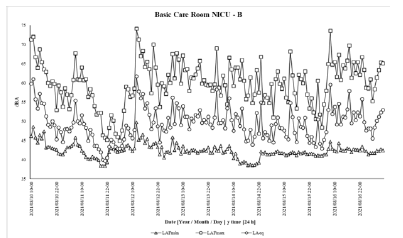
Figure 1: Acoustic indices for 7 continuous days at 1-hour intervals in NICU-B. The lowest noise levels are shown with a continuous line with a triangle marker and the highest with a square marker
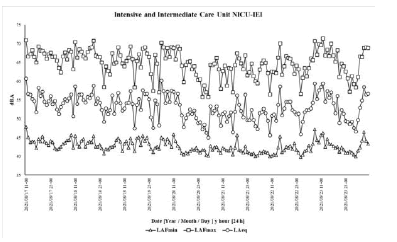
Figure 2: Acoustic indices for 7 continuous days at one-hour intervals in the NICU-IEI. The lowest noise levels are shown with a continuous line with a triangle marker and the highest with a square marker
The NICU-IEI room presents a greater uniformity, since this room is in constant activity, due to the normal presence of 7 to 12 neonates and medical personnel concentrated in this room.
The averaged acoustic parameters per hour for the NICU-B shows that the LAFmax values were between 44.9 dBA-74.1 dBA, the LAFmin values were 38.3 dBA-49.7 dBA, and the LAeq were 39.7 dBA-61.7 dBA (Figure 1). Likewise, the averaged acoustic parameters per hour registered at the NICU-IEI presented LAFmax values ranging from 55.8 dBA-71.4 dBA, LAFmin, 39.8 dBA-47.9 dBA, and LAeq values between 45 dBA-
60.7 dBA (Figure 2).
Considering an average of the LAeq values for each day, it was observed that the highest noise levels were recorded during weekdays (days 1-4, 7) and that the noise levels decreased during the weekends (days 5 and 6).
Consequently, it was determined that the noisiest day at the NICU-B was day 3 which has an LAeq average value of 51.5 dBA. Whereas the noisiest day at the NICU-IEI was day 1 with an LAeq average value of 54.9 dBA.
Considering the LAeq, it is observed that the noise levels in both rooms exceeded the standards recommended by health agencies (WHO, AAP), presented in Table 1, meaning the 45 dBA for the daytime and the 35 dBA for the nighttime, as well as, the 45 dBA recommended by the TULSMA at night. Thus, those noise levels only, comply with the TULSMA recommendations, since the level equivalent for the daytime period (7:01 h-21:00 h) is 55 dBA.
The LAeq analyses by percentiles (L10 and L90) are shown in Figure 3 for the NICU-B and Figure 4 for the NICU-IEI. These represent the average hourly rates of the percentiles of the equivalent continuous noise levels. The L10 for the NICU-B shows that for 10% of the time for the period measured, the noise level ranged between 50.3 dBA-60.2 dBA, while in the NICU-IEI, the L10 values were between 55.1 dBA-61.5 dBA. In both NICUs, the highest peak levels were detected during feeding times which start at 2:00 am and continue every 3 hours throughout the day. Additionally, other high peaks were observed at 07:00 am which corresponded to the shift change of the medical staff.
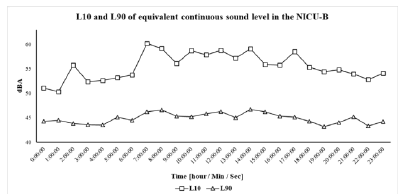
Figure 3: L10 and L90 of equivalent continuous sound level in the NICU-B. The L10 is represented with a continuous line with a square marker, while the L90 is represented with a continuous line with a triangle marker
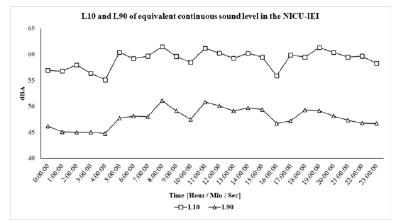
Figure 4: L10 and L90 of the equivalent continuous sound level in the NICU-IEI. The L10 is represented with a continuous line with a square marker, while the L90 is represented with a continuous line with a trian- gle marker.
The L90 indicates that for 90% of the time the noise levels were between 43.2 dBA-46.7 dBA at the NICU-B, and 44.8 dBA-51.5 dBA at the NICU-IEI. These levels in both rooms are exceeding those recommended by the WHO and CPG, but comply with the Ecuadorian regulation, TULSMA.
Figure 5 presents the hourly integrated values of the equivalent continuous noise level for the 7-day period in the studied NICUs. Figure 5 shows that in both rooms the highest activity occurs in the morning hours between 7:00 h-14:00 h, due to medical work such as administering medications, taking vital signs, cleaning the neonate, moving the patient for examinations, etc. Recorded LAeq values fluctuate between 49.8 dBA and 56 dBA [31,32]. Subsequently, at 17:00 h there is a different trend between each room, while at that time the NICU-B experiences a considerable decrease in noise levels, the NICUIEI continues with high levels until 22:00 h. The absolute minimums occur in both rooms between 3:00 h-4:00 h (46.5 dBA-
49.3 dBA), then an increase of noise is registered until the maximums of 52.5 dBA in the NICU-B and 56 dBA in the NICUIEI are reached at 7 h and 8 h, respectively.
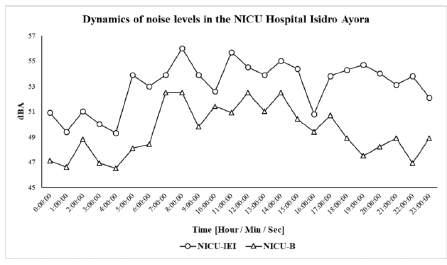
Figure 5: Linear representation of the integrated values of the equiv- alent continuous sound level (24 hours) for 7 days at the NICU-B and NICU-IEI
Similarly, as described in (Figures 3, 4 and 6) shows that higher levels of noise were recorded during the feeding time every three hours. At night lower noise levels were registered due to minor activity in the care. Other studies reported that medical and or family visits intensify noise levels, however, during this study, family visits in particular, were restricted due to the COVID-19 outbreak [22,27,31].
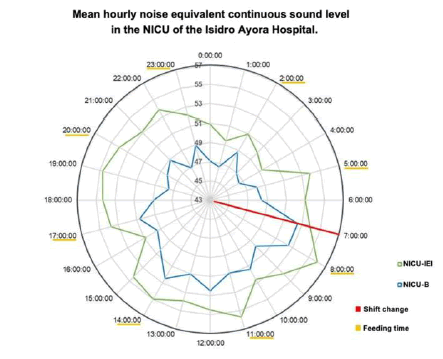
Figure 6: Circular representation of the integrated values of the equiv- alent continuous sound level (24 hours) for 7 days at the NICU-B and NICU-IEI
Finally, different statistical tests were performed to analyze the data obtained during the study. Regarding the normality tests (Table 2) with a confidence interval of 95%, data shows that 1 hour periods follow a normal distribution for both the NICU-B and the NICU-IEI since the p-values are greater than
0.05. In addition, the corresponding average was obtained for each room, therefore, the value for the NICU-B is 49.4 dBA and
53.1 dBA for the NICU-IEI, being these values much higher than those recommended by the WHO and AAP, however, they are within the ranges recommended by the TULSMA, however, it is necessary to consider mostly the indexes recommended by the health agencies, since they specifically mention the maximum noise levels for the interiors of intensive care units and in this case neonatal units (Table 3).
| Normality tests |
| |
Kolmogorov-Smirnova |
Shapiro-Wilk |
| |
Statistical |
df |
p-value |
Statistical |
df |
p-value |
| NICU-IEI |
0,067 |
168 |
0,061 |
0,987 |
168 |
0,106 |
| NICU-IEI |
0,061 |
168 |
0,200* |
0,991 |
168 |
0,342 |
Table 2: Normality tests for the data obtained from the sampling
| Group statistics |
| |
Rooms |
N |
Mean |
Standard Deviation |
Mean error |
| LAeq1h |
NICU-IEI |
168 |
53,10 |
3,289 |
0,254 |
| |
NICU-IEI |
168 |
49,39 |
4,154 |
0,320 |
Table 3: Mean for each neonatal intensive care unit room
Finally, using the t-Student test it was possible to define that the average values obtained for each room are significantly different since at a 95% confidence interval, the average noise level of the intensive and intermediate care room is higher than that of the basic care room with a difference of 3.7 dBA (Table 4).
| Test of independent samples |
|
T-test for equality of means |
|
|
|
|
|
|
|
t |
df |
p-value
(bilateral) |
Difference in means |
Standard error difference |
95% confidence interval of the difference |
|
|
|
|
|
|
Inferior |
Superior |
| LAeq1h |
9,060 |
334 |
0,000 |
3,704 |
0,409 |
2,900 |
4,508 |
Table 4: Student’s t-test for equality of means
Discussion
The LAeq values recorded in the NICUs of the Isidro Ayora Hospital coincide with the exposed by other authors which range between 48 to 76 dBA [28,30-34]. However, in this study lower hourly values, between 39.7 and 45 dBA, were recorded. Although these values were only reached on day 2 of sampling in the NICU-B when newborns were absent within the unit. Next, under regular activities in the unit, such as newborn admission or medical visits, peak values up to 61.7 dBA were reached. Similarly mentioned that during the day noise levels are expected to be higher, given that different activities are performed regarding the care and treatment of patients, including administering medicines, taking vital signs, cleaning the neonate, mobilization of the patient for examinations, etc [28,30].
Zamani mentioned that noise levels are related to the number of medical staff and patients, routine studies, visiting hours, and particularly feeding time [35]. The peak values (L10) were recorded during feeding times during the time of admission, when mothers need to perform cleaning tasks such as washing hands, dragging chairs, and talking, among others. Fortes, noted an increase in noise levels in peaks of 4 dBA to 6 dBA during feeding times in facilities where the mothers have access to feed their children; a noteworthy fact since some newborns need to be fed in 3-hour intervals. Whereas, in NICUs where children are fed by nasogastric tubes the sound levels remain low during feeding times as reported [31].
On the other hand, Fortes testified that weekdays are the noisiest compared to weekends when there is less active personnel in the unit, a similar case as encountered in this study. In contrast, a study by Mayhew reported a subtle difference, of 2 dB higher noise levels measured during weekends in contrast to weekends [36]. In that study, noise measurements were recorded using a logarithmic scale where a small dB increase represents a considerable increase in sound intensity [37]. Thus, considering the recorded data, and as suggested by Disher and Lmax can be considered the best outcomes to define behavioral interventions.
Comparing the average values obtained for each room, the NICU-B (49.4 dBA) and NICU-IEI (53.1 dBA), with environmental noise guidelines, it was proved that these exceeded the noise recommended levels, which is why several authors agree on the need to implement corrective measures and noise mitigation, by evaluating the dynamics inside the NICUs [23,31]. In developing countries such as Ecuador, due to budgetary situations, the main and most practical measures to accomplish in the short term, involve preventive and educational actions [37-40]. As cited by several authors, in developed countries, education on self-care, patients’ well-being, and improvements in health and work are essential, thus implemented on a routine basis. Under any circumstances, developing countries could be considered as a separate case [39-42]. Based on the observations made inside the neonatology area of the Isidro Ayora Hospital, and reported studies different criteria were considered to propose a noise mitigation program [41]. Staff awareness, continuous education aiming at a cultural change of the staff, and establishment of good medical practices such as carrying out noise controls for decision making, are required.
Periodical staff training and acoustic signals are necessary and affordable. Purchasing new equipment or making infrastructural modifications at a NICU cannot be overlooked. Even though structural modifications represent high costs; it is important to consider a greater reduction in noise levels through modifications in terms of design such as an expansion of the units, implementation of sound-absorbing panels, maintenance of doors, wheels, and fans, removing equipment that tends to cause false alarms, and moving noisy equipment far away from the neonates [42,43]. Reported cases, indicate that those types of interventions could help to reduce noise levels up to 5 dBA to 15 dBA, while, education and awareness programs could lead to a reduction in noise levels of 1.1 dBA [44,45]. Although, this latter would not be enough to comply with the acceptable noise levels established by national or international laws should be considered. Based on the fact, that null to sporadic attention is given to noise control at public and probably private hospitals, in countries like Ecuador; it is recommended to share this study with the medical staff, nurses, parents, and executive managers of hospitals to promote frequent noise control and collective awareness to improve the acoustic environment. Additionally, we suggest the development of studies with health professionals to evaluate the relationship between noise and the physiological responses of newborns hospitalized at NICUs of not only the studied hospital but others in the country.
Conclusion
The noise measurements determined during the experimental phase exceeded the limits recommended by international and national organizations. Noise levels registered in the NICUs are proportional to the services provided in each one of them. The greatest number of patients, medical staff, and equipment are concentrated in NICU-IEI, therefore its LAeq is higher (53.1 dBA) than the one in NICU-B (49.3 dB).
The highest noise levels were registered during feeding periods, especially during the daytime. Hence, more awareness should be devoted to these time slots since the main factor that increases noise is caused by mothers and nurses assisting newborns.
This study was carried out in a developing country however, our results do not differ from studies performed in developed countries where, in the same way, they do not comply with the maximum acceptable noise limits, yet noise levels are monitored, education is given, and more investments on health control are done.
Preventive measures suggested for Ecuador, range from sensitization programs for medical personnel to mitigating measures focused on acoustic insulation using soundproof panels, which have given positive results in the reduction of noise in other studies.
Implementing corrective measures to reduce the noise levels to which newborns and health professionals are exposed is essential. Therefore, ideas to develop a noise mitigation program are presented based on local and international noise regulations and recorded data. Further work should be done to address the main deficiencies observed and found in this study and whose improvement will depend on the participation of the team of professionals that make up the neonatology area.
Authors Contribution
Conceptualization: David Emmanuel del Pozo, Manuel Jesús Gázquez; Methodology: David Emmanuel Del Pozo, Bryan Gabriel Valle, Manuel Jesús Gázquez; Formal analysis and investigation: David Emmanuel Del Pozo, Natalia Carolina Donoso, Galo Antonio Ojeda, Bryan Gabriel Valle, Manuel Jesús Gázquez; Writing-original draft preparation: Natalia Carolina Donoso, Galo Antonio Ojeda, David Emmanuel del Pozo; Writing-review and editing: Natalia Carolina Donoso, Galo Antonio Ojeda; Resources: David Emmanuel del Pozo; Supervision: David Emmanuel del Pozo.
Acknowledgement
None.
Competing Interest
The authors declare that they have no competing interests.
Ethics Approval
This study was granted an exemption from requiring ethical approval by the ethics committee of the Isidro Ayora General Hospital. The study was approved by the Medical Director of Hospital Isidro Ayora de Loja. Patients were not enrolled for direct noise measurements.
Additional Information
The datasets generated during and/or analysed during the current study are available from the corresponding author on reasonable request.
References
- Carpio CR, Figueroa WE, Alvarado MP (2015) Innovation management system of Ecuador. Pro Soc Beha Sci 195: 157-166.
[Crossref] [Google Scholar] [PubMed]
- Cañarte J (2020) Scientific production: A relationship of the PIB of Ecuador and Latin America. Mas Sci 6(3): 920-934.
[Crossref] [Google Scholar]
- Tapia E (2022) Investment in health and education falls 80% in 2022.
- Paz Cardona AJ (2020) For Ecuador, a litany of environmental challenges awaits in 2020, Mongabay. News and Inspiration from Nature’s Frontline.
- Moncayo BL (2017) Contingent valuation of road traffic noise: A case study in the urban area of Quito, Ecuador’. Case Stud Trans Pol 5(4): 722-730.
[Crossref] [Google Scholar]
- Moncayo BL (2019) A cost-effective approach to the evaluation of traffic noise exposure in the city of Quito, Ecuador. Case Stud Trans Pol 7(1): 128-137.
[Crossref] [Google Scholar]
- Maurice L (2019) Drinking water quality in areas impacted by oil activities in Ecuador: Associated health risks and social perception of human exposure. Sci Total Environ 690: 1203-1217.
[Crossref] [Google Scholar]
- Mendoza CI (2020) Spatial estimation of chronic respiratory diseases based on machine learning procedures: An approach using remote sensing data and environmental variables in quito, Ecuador. App Geo 7(1): 128-137.
[Crossref] [Google Scholar]
- Barraza F (2020) Contrasts in chemical composition and oxidative potential in PM10 near flares in oil extraction and refining areas in Ecuador’. Atm Environ 223: 117302.
[Crossref] [Google Scholar]
- Peñafiel P, Cazares K, Marizande D (2018) Evaluation of the noise pollution of the Cevallos avenue, Ambato city, Ecuador, for the determination of critical points of affectation in the place, and to provide information that allows the generation of preventive and corrective measures to the problem. Multi Sci 9(2): 26-38.
[Crossref] [Google Scholar]
- Gupta A (2018) Noise pollution and impact on children health. Indian J Pediatr 85(4): 300–306.
[Crossref] [Google Scholar]
- Romeu J (2016) Assessment of environmental noise and its effect on neonates in a neonatal intensive care unit. Applied Acoustics 111: 161-169.
[Crossref] [Google Scholar]
- Ahamed MF (2018) Noise reduction in the neonatal intensive care unit: A quality improvement initiative. Am J Med Qual 33(2): 177-184.
[Crossref] [Google Scholar] [PubMed]
- Venkataraman R (2018) Is less noise, light and parental caregiver stress in the neonatal intensive care unit better for neonates? Indian Pediatr 55(1): 17-21.
[Crossref] [Google Scholar]
- Edwards EM, Horbar JD (2018) Variation in use by NICU types in the United States. Pediatr 142(5): 10-15.
[Crossref] [Google Scholar]
- Chawla S. (2017) A targeted noise reduction observational study for reducing noise in a neonatal intensive unit. J Perinatol 37(9):1060–1064.
[Crossref] [Google Scholar]
- Barbieri I, Anna E, Strini V (2018) Acoustic pollution in neonatal and paediatric intensive care units: A literature review. Profess inferm 71(3): 139-150.
[Crossref] [Google Scholar] [PubMed]
- Ozdemir S, Balci S (2020) The effect of earmuffs on physiological parameters in preterm infants: A systematic review. Curr Pediatric Rev 16(2): 156-163.
[Crossref] [Google Scholar]
- Khowaja S (2022) Measurement of sound levels in a neonatal intensive care unit of a tertiary care hospital, Karachi, Pakistan. Pediatri Neonatol 63(6):618-624.
[Crossref] [Google Scholar]
- Almadhoob A, Ohlsson A (2020) Sound reduction management in the neonatal intensive care unit for preterm or very low birth weight infants. Coch Dat System Rev 30(1): CD010333.
[Crossref] [Google Scholar] [PubMed]
- Ambiente MD (2017) Unified text of secondary environmental legislation.
- Neille J, George K, Shangase KK (2014) A study investigating sound sources and noise levels in neonatal intensive care units. South Afric J Child Bir 8(1): 1-5.
[Crossref] [Google Scholar]
- Galindo AP, Pereira AM, Caicedo CY (2017) Noise level in a neonatal intensive care unit in Santa Marta Colombia.’ Colomb Méd 48(3): 120-125.
[Crossref] [Google Scholar]
- Carvalhais C (2021) The impact of structural changes on sound pressure levels in a neonatal intensive care unit. Arch Acoust 46(3): 435-442.
[Crossref] [Google Scholar]
- WHO (2018) Preterm birth, Fact Sheets.
- INEC (2019) Vital statistics births and deaths
- Cardoso SMS (2015) New born physiological responses to noise in the neonatal unit. Braz J Otorhinol 81(6): 583–588.
[Crossref] [Google Scholar] [PubMed]
- Chávez DA (2018) Measurement and analysis of noise levels in a neonatal intensive care unit. Medical Ann Med Ass ABC Med Cen 63(3):165-168.
[Crossref] [Google Scholar]
- Casavant SG (2017) Noise in the Neonatal Intensive Care Unit. Adv Neonatal Care 17(4): 265–273.
[Crossref] [Google Scholar]
- Voitl P (2019) Noise levels in general pediatric facilities: A health risk for the staff? Plos One 14(3): e0213722.
[Crossref] [Google Scholar]
- Garrido JC (2014) The characterization of noise levels in a neonatal intensive care unit and the implications for noise management. J Environ Health Sci Engin 12(1):104.
[Crossref] [Google Scholar]
- Joshi G, Tada N (2016) Analysis of noise level in neonatal intensive care unit and post natal ward of a tertiary care hospital in an urban city. Int J Contem Pediatri 5: 1358-1361.
[Crossref] [Google Scholar]
- Myszograj S, Koropczuk PE, Jakubaszek A (2017) Cod fractions methods of measurement and use in wastewater treatment technology. Civ Environ Engin Rep 24(1): 195-206.
[Crossref] [Google Scholar]
- Capriolo C (2022) Assessment of neonatal intensive care unit sound exposure using a smartphone application. Am J Perinatol 39(02): 189-194.
[Crossref] [Google Scholar] [PubMed]
- Zamani K (2018) The effect of staff training on the amount of sound pollution in the intensive care unit. J Nurs Midwif Sci 5(4):130.
[Crossref] [Google Scholar]
- Mayhew KJ (2022) Elevated sound levels in the neonatal intensive care unit. Adv Neonat Care 22(6):E207-E216.
[Crossref] [Google Scholar]
- Disher TC (2017) Striving for optimum noise decreasing strategies in critical care. J Perinat Neonatal Nurs 31(1): 58-66.
[Crossref] [Google Scholar]
- Filus W, Lacerda A, Albizu E (2014) Ambient noise in emergency rooms and its health hazards. Int Arch Otorhinolaryngol 19(03): 205-209.
[Crossref] [Google Scholar]
- Santos J (2018) Assessment andracterization of sound pressure levels in Portuguese neonatal intensive care units. Arch Environ Occup Health 73(2): 121-127.
[Crossref] [Google Scholar]
- Astin F (2020) Night time noise levels and patients sleep experiences in a medical assessment unit in Northern England. Open Nurs J 14(1): 80-91.
[Crossref] [Google Scholar]
- Carvalhais C (2021) The impact of structural changes on sound pressure levels in a neonatal intensive care unit. Arch Acoust 46(3): 435-442.
[Crossref] [Google Scholar]
- Luetz A (2016) Feasibility of noise reduction by a modification in ICU environment. Physiol Meas 37(7): 1041-1055.
[Crossref] [Google Scholar]
- Negreira J (2020) Noise level reduction in neonatal units.
- Bliefnick JM, Ryherd EE, Jackson R (2019) Evaluating hospital soundscapes to improve patient experience. J Acoust Soc Am 145(2):1117-1128.
[Crossref] [Google Scholar] [PubMed]
- Zijlstra E (2019) The effect of a non-talking rule on the sound level and perception of patients in an outpatient infusion center. PLOS ONE 14(2):e0212804.
[Crossref] [Google Scholar]
Citation: Del Pozo DE, Donoso NC, Ojeda GA, Valle BG, G�¡zquez MJ (2023) The Need to Implement Noise Reduction Measurements in a Neonatal Intensive Care Unit in Hospitals in Low and Middle Income Countries-a Case Study. Divers Equal Health Care. 21:37.
Copyright: © 2023 Del Pozo DE, et al. This is an open-access article distributed under the terms of the Creative Commons Attribution License, which permits unrestricted use, distribution, and reproduction in any medium, provided the original author and source are credited.







